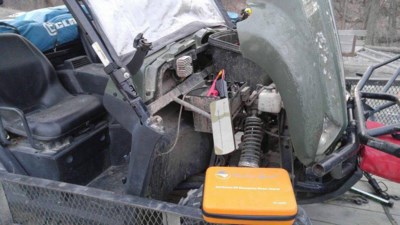Living in northeastern Ontario when the temperatures drop well below zero in the winter, motorist face the possibility vehicles not starting.
Many of us take for granted that our vehicles will start. However, this wasn't the case for me. One evening, the temperature dropped to minus 36 C. The next morning I went to start my truck. I turned the key. Nothing. I tried again and nothing. Although I had it plugged in all evening, it didn't have the power to turn the engine over.
I walked back into my house where I had a jump starter handy next to the front door. After setting it up and turning on the power, I got back into the truck and turned the key. The truck fired up right away with no problem whatsoever.
I have made it a habit to carry it all summer in my boat just in case I drain my battery that starts my main engine, and runs the live well and my electronics. Carrying a jump starter has allowed me a means of boosting the battery if needed to eliminate any chance of getting stranded on the water.
After I winterized my boat, I figured that I would be a good idea to carry it my truck during the winter months just in case my truck wouldn't start or someone else might need a boost.
 A battery booster in action
A battery booster in actionIn the email was a link to an article with some interesting information. For example, batteries are effective just as much in the summer to heat as they are in the winter. Your typical lead acid battery capacity drops about 20 percent from normal in colder weather, 50 percent when temperatures drop to minus 22 degrees Fahrenheit, and starters use more power during these colder temperatures.
If you think only your vehicle battery can freeze and loose charge, you're mistaken. The more our snowmobile or ATV battery becomes discharged, the more the battery electrolyte becomes water. The acid absorbs into the lead plates. Discharged batteries will begin freezing at 32 degrees F which can lead to cracked cases or buckled plates, so be sure to inspect yours regularly.
This got me thinking about how many manufacturers now produce snowmobiles and ATVs with electric starters, so I called Mike Mason at Mikey's General Sales and Services to find out if manufacturers still produce pull starts.
Mike told me that many snowmobiles and ATV manufacturers use pull starts. However, a customer can have one installed in their snowmobile or ATV.
Mike went on to say that salesmen do suggest to their customers they purchase a jump starter for safety reasons should they choose not to have one installed.
Each year, snowmobilers hit the trails and anglers head to those far back lakes they aren't able to reach during the warmer months. Many take it for granted their snowmobiles or ATVs will start when it's time to leave. What happens if they don’t? If you're not with anyone, it could mean a long walk out in cold temperatures only to return with a fresh battery or some sort of booster pack the next day.
Another scenario would be, after a long day out snowmobiling, fishing, snowshoeing or cross country skiing some where in the back country, you return to your vehicle and it won't start. Sure, you can ride your snowmobile or ATV out, but you'll still have to come back later with a booster pack, a new battery or find someone to boost you.
For the cost of one of these little power jump starters, having one with you at all times might just save you from a cold walk out, the added expense of leaving your snowmobile or ATV behind or having a tow truck come out and boost your vehicle should no one be around with a set of booster cables.
I little tip I would suggest is to bring your jump starter inside each night and place it somewhere you can easily grab it when you head out the next day. If you're going ice fishing and have a fish hut, bring it in with you. If not, place it in one of the inside pockets of your jacket so it will stay warm. By doing this, your jump starter won't be at risk of loosing any of it's power and it will be fully charged should you need it.
I'd like to wish everyone a Happy New Year and remember, be safe this winter.
Whether you're an angler or hunter; a camp, lodge, resort owner; or just holding an outdoor event and would like some exposure, please feel free to email us at [email protected]



